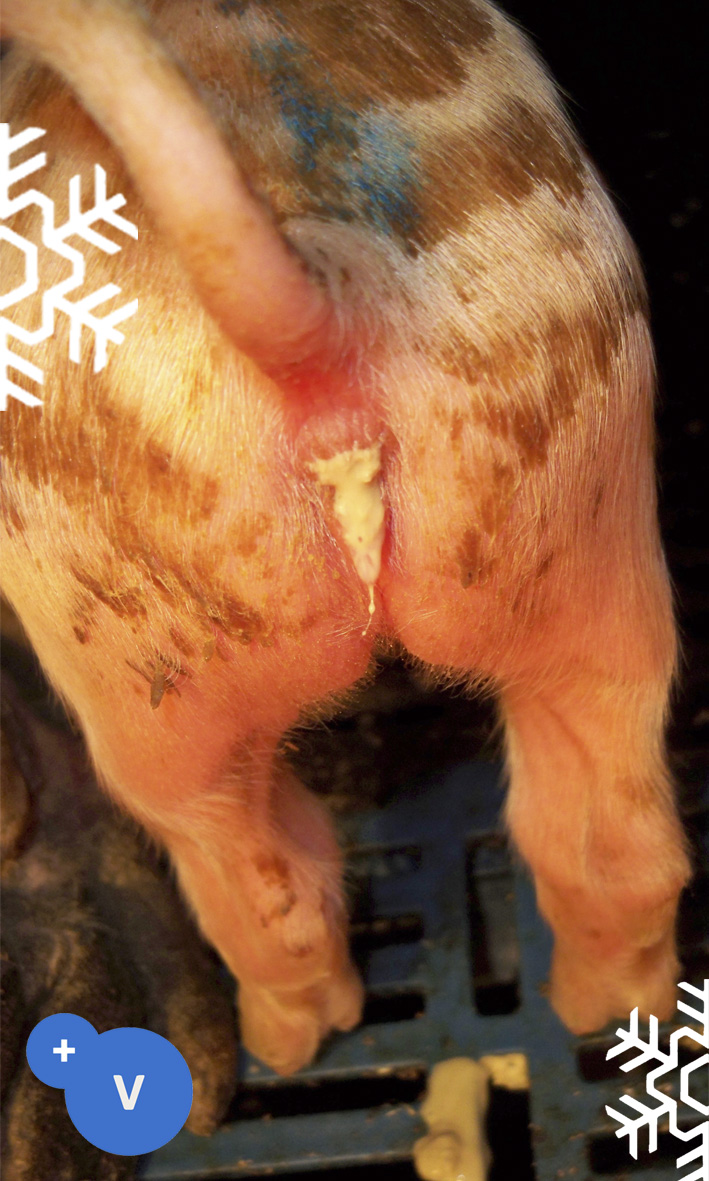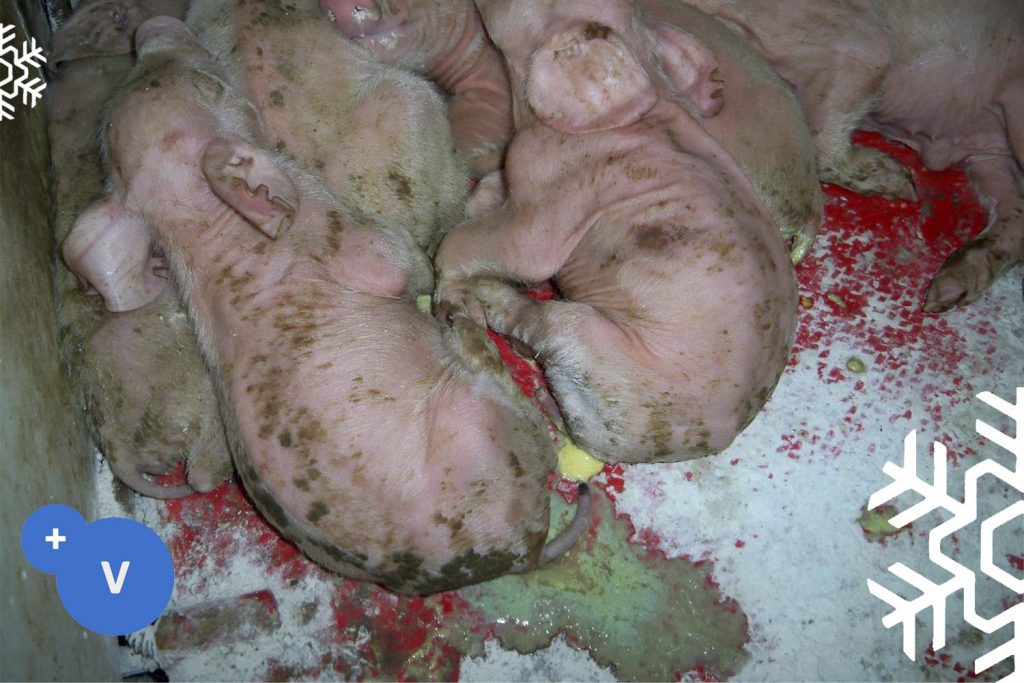01 Jan Keep your suckling piglets growing healthy during the cold season!

The incidence of digestive problems increases during the cold days of winter and also in early spring, due to the sudden changes in temperature from day to day and the big thermal oscillation between day and night.
Severe epidemics are more common during these seasons because suckling piglets are very sensitive to cold environments and, furthermore, certain pathogens are able to survive even in low temperatures.
Outbreaks of digestive diseases in suckling piglets are responsible for huge economic losses due to mortality, morbidity, decreased growth rate, cost of medication and man power expenses.
Pathogenesis and predisposing factors
The most common causes of diarrhea at this age are several types of viruses, E.coli, Clostridium sp. and coccidia.
Various factors make the animals susceptible to the diseases, to name a few: piglets with low weight or low immunity; cold stress; aspects related to colostrum and milk intake; dirty environment and vertical transmission of pathogens from the sow to the litter through the contact with skin or faeces.
Clinical Findings
The clinical findings and lesions vary according to the pathogenesis of the disease. Diarrhea is the universal sign, with liquid feces that range from creamy to completely watery. Other signs may be vomit, depression, refusal to nurse and dehydration.

Among all the pathogens, enterotoxigenic E.coli and certain viruses such as TGE and PEDV are those linked to the highest mortality. To my experience, mortality can peak to 80%-100% in piglets up to 3 days-old, and be more than 60% in piglets from 4 to 7 days-old.
Current practices for treatment
In case of bacterial diarrhea, antimicrobials are administered orally or by injection, although there are increasing resistant microorganisms, therefore the effectiveness of the treatment is irregular. Gentamicin by injection is the most popular treatment in our markets. Due to the contagious nature of the pathogens, all pigs in the litter (including those not affected by diarrhea) should be treated at the same time.
Antibiotics are not effective in viral infections and the lack of positive response to antibiotic treatment is extremely frustrating for the local farmers. Good husbandry and nutrition together with supportive therapy can be useful.
Advised holistic program for treatment and prevention
1. MANAGEMENT
1.1. Disinfection and biosafety
- Practice all-in all-out philosophy, with appropriate cleaning, disinfection and drying between batches.
- Remove dirty bedding and feces daily.
- The hands, coveralls and boots of personnel serve as mechanical vehicles for pathogens. Therefore, it is necessary to change coveralls and boots (or use a footbath) plus washing hands before entering the house. Gloves should be changed regularly, i.e. between litters.
- Wash the sow and disinfect the teats before farrowing.
- Restrict the entrance of visitors and the control the transit of workers through the several houses, to avoid the spread of diseases.

1.2. Temperature control
New born piglets have very little energy reserves, therefore they are not ready to adapt to cold environments. If exposed to cold, piglets quickly metabolize fat and glycogen in an attempt to stay warm and become hypoglycemic, weak and inactive. Chilled piglets may die of starvation, disease or may be crushed to death by the sow.
I have done some statistical work on the death of young piglets and have observed that many piglets die during the night due to management negligence and low temperatures.
A proper farrowing environment provides a special, heated area for the newborn piglets with the temperature reduced gradually from 32-35ºC at birth to 25-28ºC one week later. The area of the sow must be kept at 20-22ºC.
According to my practical experience, during the outbreaks of diarrhea, one should in the first place examine the temperature of the pens. Right after, the use of drying powders on the skin of the piglets helps the animals to maintain the temperature of the body and reduces mortality.
1.3. Ventilation
Piglets need good air quality to survive and grow. Farrowing houses are known to be dusty, because sow’s feed tends to be dusty. Besides, during cold seasons, there is the tendency to close all the natural openings such as windows in order to keep the temperature in the pen and save energy. This leads to poor air quality that contributes to the spread the diseases.
Therefore, farrowing units need artificial ventilation during cold seasons, but air movement must be slow and cold airflows that could chill the piglets should be carefully avoided.
2. ANIMAL HEALTH PRODUCTS FOR TREATMENT
Antibiotics are the treatment of choice for diarrhea outbreaks that have been caused by bacteria sensitive to antibiotics. But antibiotics are not helpful neither in the increasing cases of infections by resistant bacteria nor against viral diseases. Besides, antibiotics do not solve directly the problems associated to diarrhea, such as dehydration. Moreover, antibiotic abuse is often the cause of a slow growth during suckling period and one reason for poor weight at weaning, because antibiotics will kill beneficial intestinal bacteria while they eliminate pathogenic microorganisms. Once we ensure that the environment in the farrowing pen is optimal, we feed piglets with a cocktail of phyto-active ingredients, electrolytes and vitamins and we can complete recovery in 2-3 days.- Some phytoactive ingredients are microbiocide, fighting the pathogenic bacteria and reducing the risk of secondary infections in the case of viral diseases. Other phytoactive ingredients are able to stimulate the growth of favorable bacteria in the gut. This feature is especially interesting in suckling animals, because their gut flora is under development, as we discussed in this blog.
- Electrolytes and rapidly absorbed sugars provide excellent nutritional support to suckling animals, especially to ill animals, that may have losses of nutrients through watery faeces.
- Vitamin E is related with a higher piglet body weight, a better health status at weaning and with a better immunity status.
In mild infections
During mild infections, with moderate signs and low mortality, the use of phyto-active ingredients, electrolytes and vitamins proves to be effective within 24-48 h, showing a clear improvement of the appearance of feces and of the status of the animals.In case of explosive diarrhea outbreaks with high mortality
Many experiences in different areas show that the use of phyto-active ingredients, electrolytes and vitamins reduces the negative consequences of explosive outbreaks with high mortality, being able to cut down the mortality from higher than 60% to less than 40%.
3. ANIMAL HEALTH PRODUCTS FOR PREVENTION
3.1. Recommended products for piglets
The use of phyto-active ingredients, electrolytes and vitamins since day 1 helps the establishment of a healthy flora, improves the digestion and supports immune function, resulting in a
- 20% better weight at weaning.
- Dramatic reduction of the occurrence of diarrhea and of the need of antibiotics to treat scours.
- Mortality is cut down by more than 80%.

3.2. Recommended products for sows
To reduce the vertical transmission of pathogens from sows to piglets, I recommend the addition to feed a combination of phytoactive ingredients, vegetal oils rich in omega-3 and organic acids during all the gestation period and all the lactation. Such combination keeps the digestive system of the sow healthy and improves the nutritional quality of colostrums and milk, therefore indirectly reducing the occurrence of diarrhea in the piglets, as we discussed in this blog entry.

Products of choice
ActiPlus© is a liquid emulsion that contains:
- Essential oils with antioxidant, immunostimulant and microbiocide, which have a positive action on the digestive system.
- Plant extracts with prebiotic effect
- Electrolytes to maintain hydration
- Fast absorbing sugars as an energy source
- Vitamin E, essential for young mammals
It is intended for young mammals such as piglets, calves, lambs and kids during the lactation period, and is administered directly into the mouth of the animal.
ReproPlus© es un producto en polvo prémix indicado para mantener y mejorar la salud digestiva en cerdas gestantes y lactantes. Está formulado con ingredientes sinérgicos:
- Fitobióticos bactericidas y fungicidas, combinados con ácidos orgánicos.
- Fitobióticos inmunoestimulantes y antioxidantes.
- Extractos de plantas con efecto prebiótico.
- Aceites vegetales ricos en omega 3.
- Silicatos con función secuestrante de micotoxinas.

Certain health statements may not be applicable in your region.

